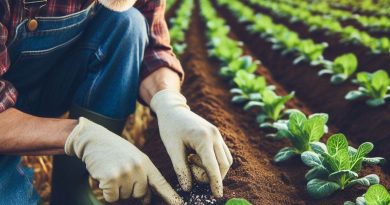Harvesting Hints for Maximum Yield
Last Updated on February 8, 2024
Introduction
Maximizing yield is crucial in farming as it directly impacts profitability and food production efficiency.
One key aspect of achieving maximum yield is implementing effective harvesting techniques.
In this blog section, we will explore various harvesting hints that can help farmers optimize their yield and increase overall productivity.
Importance of Maximizing Yield in Farming
In the world of agriculture, maximizing yield holds immense significance.
By increasing the amount of crops produced per unit of land, farmers can meet the growing demand for food, feed larger populations, and contribute to food security.
Moreover, higher yields result in improved profit margins, promoting sustainable farming practices and economic growth.
Introducing Harvesting Hints for Maximum Yield
Now, let’s delve into the topic of harvesting hints for achieving maximum yield.
Harvesting is a critical phase in the farming cycle that demands careful planning and execution.
By implementing specific strategies and employing appropriate techniques, farmers can optimize their harvest, resulting in increased yield and quality of crops.
During this section, we will explore a range of harvest-related aspects such as optimal harvesting time, proper handling and storage, efficient post-harvest techniques, and the role of machinery and technology.
These hints and practices will help farmers make informed decisions to maximize their yield, reduce wastage, and minimize losses.
As we progress through the section, we will delve into each harvesting hint in detail, providing practical advice and insights.
By following these recommendations, farmers can improve their crop production and take significant steps towards achieving maximum yield, ultimately contributing to the global agricultural community.
Let’s explore the world of harvesting hints and unlock the potential for abundant yields!
Selecting the Right Time for Harvesting
Harvesting at the optimal time is crucial for maximizing yield and ensuring the quality of your crops.
It requires careful consideration of several factors to determine the right time for harvesting.
Here are some important points to keep in mind:
Importance of Harvesting at the Optimal Time
Harvesting at the optimal time ensures that your crops have reached their maximum yield potential.
It allows you to harvest when the crop is at its peak quality, flavor, and nutritional value.
Waiting too long or harvesting too early can significantly impact the yield and quality of your crops.
Factors to Consider When Determining the Right Time for Harvesting
Several factors play a role in determining the right time for harvesting your crops.
It is essential to consider these factors to make an informed decision:
- Crop Maturity: Assessing the maturity of your crop is a crucial factor in determining the right time for harvesting. Different crops have specific indicators of maturity, such as fruit color, size, or texture.
- Weather Conditions: Weather can greatly influence crop maturity and quality. Consider factors like temperature, humidity, and rainfall patterns. Harvesting during dry weather conditions is generally favorable to avoid crop damage or disease.
- Crop Variety: Each crop variety has its own optimal harvest time. It is important to consult the seed supplier or refer to credible sources that provide information specific to the crop variety you are growing.
Tips to Identify Signs of Crop Readiness for Harvesting
To determine if your crops are ready for harvesting, keep an eye out for these signs of readiness:
- Color Change: Many fruits and vegetables change color as they ripen, indicating they are ready for harvest. For example, a green tomato turns red, showing it is ripe and ready to be picked.
- Texture: The texture of the crop can also provide clues. For instance, a ripe watermelon will have a dull skin surface and a slight give when pressed gently.
- Size: Monitoring the size of crops, such as zucchinis or cucumbers, is important. Harvesting them when they reach the desired size prevents them from becoming overripe or losing their flavor.
- Seed Development: Checking the development of seeds is crucial for certain crops like beans or peas. Harvest when the seed pods are plump and the seeds are mature.
Therefore, selecting the right time for harvesting is essential for achieving maximum yield and maintaining the quality of your crops.
Consider factors like crop maturity, weather conditions, and crop variety when making your decision.
Keep an eye out for signs like color change, texture, size, and seed development to identify crop readiness.
Harvesting at the optimal time will ensure you enjoy the best possible harvest from your hard work.
Read: Seasonal Planting Guide for Year-Round Yield
Proper Pre-harvest Preparation
Pre-harvest preparation plays a crucial role in maximizing yield and ensuring a successful harvest.
By properly preparing before the harvest process, farmers can optimize their production and minimize potential pitfalls.
Here are some essential pre-harvest practices that every farmer should follow:
Inspect Equipment
Before starting the harvest, it is crucial to inspect all the equipment to ensure they are in good working condition.
This includes checking the harvesters, tractors, and any other machinery used in the process.
Any malfunctions or issues should be addressed promptly to avoid delays during harvest.
Ensure Adequate Storage Space
Having enough storage space is vital to accommodate the harvested crops.
Farmers need to assess their storage facilities and make necessary arrangements accordingly.
This helps in preventing any damage or spoilage of the produce and allows for effective post-harvest management.
Prepare Labor
It is important to have an adequate workforce ready to handle the harvest activities efficiently.
Farmers should communicate their requirements to the laborers in advance and make sure they are available during the harvest period.
This ensures a smooth workflow and prevents any delays or bottlenecks.
Check Crop Maturity
Before starting the harvest, farmers should assess the crop maturity.
Each crop has a specific maturity stage at which it should be harvested to achieve maximum yield.
Checking for signs such as color, texture, and size helps determine the ideal time for harvest.
Weather Considerations
Monitoring weather conditions is crucial for pre-harvest preparation.
Unfavorable weather, such as heavy rains or strong winds, can impact the harvest process and potentially damage the crops.
Farmers should stay informed about the weather forecast and plan their harvest accordingly.
Arrange Harvest Containers
Having proper containers for collecting and transporting the harvested crops is essential.
Farmers should ensure they have an adequate supply of baskets, bags, or bins that are clean and in good condition.
This helps in maintaining the quality of the harvested produce.
Checklist for Farmers
Here’s a checklist that farmers can follow before starting the harvest process:
- Inspect all equipment for any malfunctions or issues.
- Assess and arrange sufficient storage space for the harvested crops.
- Communicate with laborers and ensure their availability during the harvest period.
- Check the maturity stage of the crop for optimal harvest timing.
- Stay informed about the weather forecast and plan accordingly.
- Ensure an adequate supply of clean and suitable containers for the harvested crops.
By following these pre-harvest practices and diligently completing the checklist, farmers can set themselves up for a successful harvest.
Proper preparation maximizes yield, ensures crop quality, and minimizes potential risks or setbacks.
Remember, investing time and effort in pre-harvest preparation is crucial for a thriving agricultural enterprise.
Read: Fertilizing Facts: Feed Your Plants Right

Maximizing Efficiency During Harvesting
Efficiency plays a crucial role in harvesting as it directly impacts the maximum yield that farmers can achieve.
By harvesting efficiently, farmers can optimize their resources and minimize losses, ultimately increasing their profits.
Here, we will discuss the importance of efficiency in harvesting for maximizing yield and provide valuable tips to achieve it.
The Importance of Efficiency in Harvesting
Efficiency in harvesting is vital for maximizing yield because it allows farmers to optimize their time, efforts, and resources.
When the harvesting process is efficient, farmers can complete the task promptly, ensuring that the crops are harvested at their peak condition.
This is crucial because delaying harvest can result in decreased yield and quality.
Moreover, efficient harvesting enables farmers to cover more areas within a specific timeframe.
By harvesting efficiently, farmers can increase their productivity and harvest a larger volume of crops.
This is particularly important for farmers who have large fields or limited time due to weather conditions.
The Role of Proper Machine Settings
Proper machine settings, including combine adjustments, speed, and header height, play a significant role in maximizing harvesting efficiency.
Farmers should ensure that their combine is properly adjusted to the field conditions and the crop they are harvesting.
Firstly, combine adjustments, such as rotor speed, concave clearance, and fan speed, should be optimized according to the crop’s characteristics.
This will prevent unnecessary grain damage and ensure optimal threshing and separation, leading to higher yield.
Secondly, maintaining the appropriate speed while harvesting is essential.
Farmers should adjust the combine’s speed according to the crop’s moisture content and the field conditions.
Harvesting at the right speed prevents grain losses and reduces fuel consumption.
Thirdly, header height adjustment is critical for efficient harvesting.
The header should be set correctly to ensure the optimal capture of the crop, reducing losses from shattering or leaving unharvested grain in the field.
Tips to Optimize Harvesting Efficiency
To optimize harvesting efficiency and maximize yield, farmers should follow these essential tips:
- Avoid overlapping passes while harvesting. Overlap reduction can minimize resource waste and maximize coverage.
- Regularly check the combine’s settings and make necessary adjustments throughout the harvesting process, especially when transitioning between different fields or crops.
- Utilize precision agriculture technologies, such as GPS and yield mapping, to monitor and adjust harvesting operations accurately.
- Minimize grain losses by ensuring proper combine settings, maintaining a smooth and steady harvest speed, and regularly inspecting equipment for wear or damage.
- Periodically calibrate harvesters to ensure accurate yield measurement and to make more informed management decisions.
- Avoid harvesting during unfavorable weather conditions, as it may damage the quality of the crop and increase losses.
- Incorporate preventive maintenance practices to keep harvesting equipment in optimum condition, reducing downtime and increasing overall efficiency.
Most importantly, maximizing efficiency during harvesting is crucial for farmers who aim to achieve high yields.
By emphasizing proper machine settings, including combine adjustments, speed, and header height, and following essential tips, farmers can optimize their harvesting operations, minimize losses, and ultimately boost their profits.
Read: Seed Starting Indoors: A Step-by-Step Guide
Handling and Transporting Harvested Crops
Handling and transporting harvested crops are crucial steps in preserving crop quality and maximizing yield.
Proper techniques not only minimize damage but also prevent contamination.
To ensure efficient transportation, considerations such as load size, vehicle maintenance, and timing should be taken into account.
Importance of Proper Handling and Transporting Techniques
- Preserving crop quality is vital to maintain market value and consumer satisfaction.
- Improper handling and transporting can result in bruising, crushing, or spoilage of crops.
- Crucial nutrients and moisture can be lost if crops are not handled and transported correctly.
- Preventing contamination during handling and transportation reduces the risk of foodborne illnesses.
- Using proper techniques ensures that the crop reaches its destination in optimum condition.
Best Practices for Handling Harvested Crops
- Avoid excessive roughness or pressure while handling crops, especially delicate fruits or vegetables.
- Inspect crops before harvesting, removing any damaged or spoiled produce.
- Harvest crops at the appropriate stage of maturity to maximize flavor and nutritional content.
- Sort and grade crops to separate high-quality produce from lower-quality items.
- Use appropriate containers such as crates, bins, or boxes designed specifically for the crop being harvested.
- Ensure containers are clean, free from contaminants, and properly ventilated.
- Handle crops carefully to avoid unnecessary bruising, crushing, or damage during the harvesting process.
Tips for Efficient Transportation of Harvested Crops
- Consider the load size and weight capacity of the transporting vehicle to prevent overloading.
- Maintain the appropriate temperature and humidity during transportation to preserve crop quality.
- Avoid transportation during extreme weather conditions that can negatively impact the crops.
- Regularly inspect and maintain the transporting vehicle to prevent breakdowns and delays.
- Timely transportation minimizes the time crops spend off the field, reducing the risk of spoilage.
- Plan transportation routes carefully to avoid congested or rough roads that may damage the crops.
- Clearly label containers to ensure correct identification and prevent mixing of different crops.
In essence, proper handling and transporting techniques are essential to preserve crop quality and maximize yield.
By emphasizing best practices such as minimizing damage, preventing contamination, and using appropriate containers, farmers can ensure that their crops reach the market in optimal condition.
Efficient transportation methods, including consideration of load size, vehicle maintenance, and timing, further contribute to the overall success of the harvest.
Adopting these practices will not only enhance crop yield but also maintain the satisfaction and trust of consumers in the quality of the produce.
Read: Watering Wisdom: How Much is Too Much?
Post-harvest Care and Storage
In the world of agriculture, the harvest is a crucial milestone that represents the culmination of hard work and dedication.
However, the journey doesn’t end there.
Post-harvest care and storage play a significant role in maintaining maximum yield and ensuring the fruits of labor are preserved for future use.
By following essential steps and implementing proper storage techniques, farmers can safeguard their crops and optimize their harvest.
Let’s explore the significance of post-harvest care and storage and discuss some important guidelines to ensure success.
Significance of Post-harvest Care and Storage
Post-harvest care and storage are essential for several reasons.
Firstly, crops are perishable, and without appropriate measures, they can quickly deteriorate, resulting in significant yield losses.
By adopting proper care and storage techniques, farmers can prolong the shelf life of their produce and prevent unnecessary waste.
Secondly, maintaining maximum yield ensures that farmers can meet market demands consistently and effectively.
Quality produce attracts higher prices, allowing farmers to maximize their profits and secure a sustainable livelihood.
Lastly, post-harvest care and storage are crucial to support food security and minimize dependence on external sources, particularly during off-seasons.
A well-managed storage system preserves crops for an extended period, allowing consumers to access fresh produce year-round.
Essential Steps for Post-harvest Care
Achieving optimal post-harvest care involves following a series of essential steps.
Firstly, cleaning the harvested crops is imperative.
Removing dirt, debris, and damaged or diseased parts minimizes the risk of contamination and ensures longevity.
Additionally, drying the produce thoroughly is vital. Moisture promotes the growth of microorganisms, which can spoil the crops.
Adequate drying, either through natural air drying or artificial methods, prevents mold and bacterial growth.
Treating the crops with appropriate chemicals or biological agents further protects them from pests and diseases, preserving their quality and market value.
Tips on Proper Storage Techniques
Proper storage techniques play a pivotal role in maintaining the quality and quantity of harvested crops.
Firstly, temperature control is crucial.
Each crop has an ideal storage temperature range, and maintaining it helps to extend shelf life.
Monitoring temperatures regularly and adopting cooling methods such as refrigeration or cold storage preserves the crops’ freshness.
Moreover, keeping the storage area well-ventilated and controlling humidity levels is essential to prevent moisture-related issues like rotting or mildew formation.
Regular monitoring of the storage environment, including temperature, humidity, and air circulation, allows farmers to address any issues promptly and prevent crop losses.
Pest management is another critical aspect of post-harvest care and storage.
Implementing preventive measures like proper cleaning, sealing storage containers, and using pest-resistant packaging materials combat infestations effectively.
Additionally, employing natural pest control methods such as traps or biological agents minimizes the need for chemical pesticides, ensuring a healthier and more sustainable crop storage system.
In short, post-harvest care and storage significantly contribute to maintaining maximum yield in agriculture.
By adhering to essential steps such as cleaning, drying, and treating crops, farmers can ensure the preservation of their hard-earned harvest.
Implementing proper storage techniques, including temperature and humidity control, pest management, and regular monitoring, protects the crops from spoilage and extends their shelf life.
With a focus on post-harvest care and storage, farmers can optimize their harvest and financially benefit from their efforts while contributing to food security and sustainability.
Conclusion
Maximizing yield in farming is crucial for ensuring productivity and profitability.
By implementing the following key harvesting hints, farmers can significantly increase their yield:
- Proper timing of harvest to ensure optimum crop maturity and quality.
- Implementing efficient harvesting techniques to minimize damage and loss during harvest.
- Utilizing appropriate machinery and equipment for quick and effective harvest.
- Adopting proper storage and handling practices to maintain crop quality post-harvest.
It is essential for farmers to understand the significance of these practices and implement them in their farming operations.
By doing so, they can expect to achieve maximum yield in future harvests, leading to improved profitability and long-term success.


